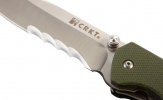Brian.Evans
Registered Member
- Joined
- Aug 20, 2011
- Messages
- 3,267
I have a customer that wants a bread knife. This is way outside my range. I don't know how or of I can even make one. Any ideas? I'm stuck.
The BladeForums.com 2024 Traditional Knife is available! Price is $250 ea (shipped within CONUS).
Order here: https://www.bladeforums.com/help/2024-traditional/

No kidding?basically its just a long blade with thin profile, and seratted all the way down the blade


3/8" round chain saw file.
Why have serrations?


Not all traditional bread knives had them, talk the client out of it.
Thin, sharp slicing knives do a fine job cutting even crusty bread, as KRIS points out.
The serrations really aren't that hard to do with a round file, practice on a piece of scrap. I make them fairly regularly, but the people who will pay good money for a bread knife are pretty far apart.
I have never made a bread knife but I have sharpened a lot of chainsaws by hand. It's only a matter of a good file guide and practice to get consistent angles. You should be able to sort out a jig/guide to make it easier. It will probably take a while. ..
THIS is what I needed! Thanks! I have some 1/16" 15n20 I'm not doing anything with. I'll play with it.I post it about every six months:
To make small close serrations-
Get a chain saw file in the desired size serration ( get several)
Get a brass rod the same size as the chain saw file.
Make the first serration with the file.
Tape the file to the brass rod at the top and bottom.
Place the brass rod in the first serration and file the second....place the brass rod in the third and file the fourth.....repeat.
After HT use a diamond file, a ceramic rod, or a rotary cylinder burr to clean up and sharpen the serrations.
Alternatives:
1) Have just a long thin blade with a 15-20° edge bevel.
2) Have large "scalloped" serrations along the edge. This is easier than it looks.
Make a long thin blade from 1/16" ( .060") stock. Taper it to an edge thickness about .020" ( no distal taper). BTW, this is a great application for the pre beveled 420 blade stock.
Put a small wheel on the grinder, say a 1" wheel. Mark the blade with a marker every 1" Make scallops in the edge at each line. This will make a blade with points every inch. ( you can make then closer with a 3/4" wheel and spacing) After HT use the same wheel and a 120 grit belt to make these scallops have an edge ( and make the points sharp). Hold the blade at about 15-20° to the small wheel so it grinds the scallop to give each scallop an edge bevel. This will also make each point sharp. Touch up with a 220 or 400 grit belt and you are done. Done right it will slay a loaf of bread or a wedding cake.
I get in a discussion with my wife about this subject every time we have a get together at our house where we serve French bread. I use a boning knife sharpened with a 120 grit belt. I do not see enough difference using the serrated blades to make the extra work worth while.
You're forgetting the part where I don't make the knife before the customer accepts the quote. I'm not making one just to throw against the wall and see if it sticks, this is a custom request. If they don't want to pay the money, then I don't make the knife.Buy a Prestige SS606 blade from Jantz and put your own handle on it. You will lose your ass trying to make a bread knife and make money on it because customers will not pay what it is worth. Just MHO.
Tim
